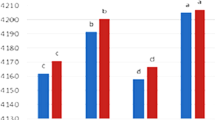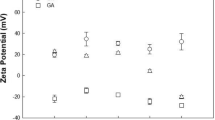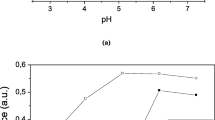Abstract
The main objective of this study is to investigate the effects of mixing and conjugation of soy protein isolate (SPI) with gum karaya on the characteristics of the hybrid polymer (protein–gum) in both aqueous systems and oil-in-water (O/W) emulsions. It was hypothesized that the covalent linkage of gum karaya with SPI would improve the emulsifying activity and rheological properties of both polymers. Conjugation occurred under controlled conditions (i.e., 60 °C and 75 % relative humidity, 3 days). The conjugated hybrid polymer produced smaller droplet with better uniformity, higher viscosity and stronger emulsifying activity than native gum karaya, suggesting the conjugated polymer provided a bulkier secondary layer with more efficient coverage around oil droplets, thereby inducing stronger resistance against droplet aggregation and flocculation. Emulsions containing the native gum karaya produced the largest droplet size among all prepared emulsions (D 3,2 = 8.6 μm; D 4,3 = 22.4 μm); while the emulsion containing protein–gum conjugate (1:1 g/g) had the smallest droplet size (D 3,2 = 0.2 μm; D 4,3 = 0.7 μm) with lower polydispersity. The protein–gum conjugate (1:1 g/g) also showed the highest elastic and viscous modulus, the lowest polydispersity (span) and the highest emulsifying activity among all native, mixed and conjugated polymers. Therefore, the percentage of gum karaya used for production of O/W emulsion can be decreased by partially replacing it with the conjugated gum.






Similar content being viewed by others
References
Li C, Bo Z, Haoran X, Zhiyan C, Qiao D, Xingguoet W (2013) Physicochemical properties of dry-heated peanut protein isolate conjugated with dextran or gum Arabic. J Am Oil Chem Soc 90:1801–1807
Yadav MP, Parris N, Johnston DB, Onwulata CI, Hicks KB (2010) Corn fiber gum and milk protein conjugates with improved emulsion stability. Carbohydr Polym 81:476–483
Báez GD, Busti PA, Verdini R, Delorenzi NJ (2013) Glycation of heat-treated β-lactoglobulin: effects on foaming properties. Food Res Int 54:902–909
Miller A, Gerrard J (2005) The Maillard reaction and food protein crosslinking. Food Biopolym Res 1:69–86
Cheftel JC, Cuq JL, Lorient D (1989) Modificaciones de las proteínas. In: Acribia SA (ed) Proteínas Alimentarias. Bioquímica. Propiedades Funcionales. Valor Nutritivo. Modificaciones Químicas Zaragoza España, Zaragoza, Spain, pp 304–309
Zhu D, Damodaran S, Lucey JA (2008) Formation of whey protein isolate (WPI)-dextran conjugates in aqueous solutions. J Agric Food Chem 56:7113–7118
Chen B, McClements DJ, Decker EA (2010) Role of continuous phase anionic polysaccharides on the oxidative stability of menhaden oil-in-water emulsions. J Agric Food Chem 58:3779–3784
Tolstoguzov VB (1997) Protein–polysaccharide interactions. In: Damodaran S, Parf A (eds) Food proteins and their applications. Marcel Dekker, New York, pp 171–198
Dickinson E, Stainsby G (1982) Colloids in food. Applied Science, London, pp 1–32
Silva D, Brito A, De Paula R, Feitosa J, Paula H (2003) Effect of mono and divalent salts on gelation of native, Na and deacetylated Sterculia striata and Sterculia urens polysaccharide gels. Carbohydr Polym 54:229–236
Singh B, Vashishtha M (2008) Development of novel hydrogels by modification of sterculia gum through radiation cross-linking polymerization for use in drug delivery. Nucl Instrum Methods B 266:2009–2020
Kasran M, Cui SW, Goff HD (2013) Emulsifying properties of soy whey protein isolate-fenugreek gum conjugates in oil-in-water emulsion model system. Food Hydrocol 30:691–697
Laemmli UK (1970) Cleavage of structural proteins during the assembly of the head of bacteriophage T4. Nature 227:680–685
Yadav MP, Strahan GD, Mukhopadhyay S, Hotchkiss AT, Hicks KB (2012) Formation of corn fiber gum–milk protein conjugates and their molecular characterization. Food Hydrocol 26:326–333
Mirhosseini H, Tabatabaee Amid B (2012) Influence of chemical extraction conditions on the physicochemical and functional properties of polysaccharide gum from durian (Durio zibethinus) seed. Molecules 17:1–16
Mirhosseini H, Tabatabaee Amid BT (2013) Effect of different drying techniques on flow ability characteristics and chemical properties of natural carbohydrate-protein gum from durian fruit seed. Chem Cent J 7:1–14
Tabatabaee Amid B, Mirhosseini H (2013) Shear flow behaviour and emulsion-stabilizing effect of natural polysaccharide–protein gum in aqueous system and oil/water (O/W) emulsion. Colloids Surf B 103:430–440
Neirynck N, Van Der Meeren P, Gorbe SB, Dierckx S, Dewettinck K (2004) Improved emulsion stabilizing properties of whey protein isolate by conjugation with pectins. Food Hydrocoll 18:949–957
Huang X, Kakuda Y, Cui W (2001) Hydrocolloids in emulsions: particle size distribution and interfacial activity. Food Hydrocoll 15:533–542
Akhtar M, Dickinson E (2007) Whey protein–maltodextrin conjugates as emulsifying agents: an alternative to gum Arabic. Food Hydrocoll 21:607–616
O’Regan J, Mulvihill DM (2010) Sodium caseinate–maltodextrin conjugate hydrolysates: preparation, characterisation and some functional properties. Food Chem 123:21–31
Thanh VH, Shibasaki K (1976) Major proteins of soybean seeds. A straightforward fractionation and their characterization. J Agric Food Chem 24:1117–1121
Davies C, Coates J, Nielsen N (1985) Inheritance and biochemical analysis of four electrophoretic variants of β-conglycinin from soybean. Theor Appl Genet 71:351–358
Nielsen NC (1985) The structure and complexity of the 11S polypeptides in soybeans. J Am Oil Chem Soc 62:1680–1686
Guan JJ, Qiu AY, Liu XY, Hua YF, Ma YH (2006) Microwave improvement of soy protein isolate-saccharide graft reactions. Food Chem 97:577–585
Mu L, Zhao H, Zhao M, Cui C, Liu L (2011) Physicochemical properties of soy protein isolates–acacia gum conjugates. Czech J Food Sci 29:129–136
Utsumi S, Matsamura Y, Mori T (1997) Structure–function relationships of soy proteins. Food proteins and their applications. Marcel Dekker, New York, pp 257–292
Murali Mohan Babu GV, Prasad CD, Ramana Murthy KV (2002) Evaluation of modified gum karaya as carrier for the dissolution enhancement of poorly water-soluble drug nimodipine. Int J Pharm 234:1–17
Márquez AL, Palazolo GG, Wagner JR, Aceites G (2005) Emulsiones tipo crema preparadas a base de leche de soja. Estudios de estabilidad y determinación de las formulaciones. Grasas Aceites 56:59–66
Kato A, Sasaki Y, Furuta R, Kobayashi K (1990) Functional protein–polysaccharide conjugate prepared by controlled dry-heating of ovalbumin–dextran mixtures. Agric Biol Chem 54:107–112
McClements DJ (1999) Food emulsions: principle, practice and techniques, 2nd edn. CRC Press, New York, pp 235–250
Williams PA (2001) Food emulsions: principles, practice, and techniques. Int J Food Sci Technol 36:223–224
Chevalier F, Chobert JM, Popineau Y, Nicolas MG, Haertlé T (2001) Improvement of functional properties of β-lactoglobulin glycated through Maillard reaction is related to the nature of the sugar. Int Dairy J 11:145–152
Kawakatsu T, Trägårdh G, Trägårdh C (2001) Production of W/O/W emulsions and S/O/W pectin microcapsules by microchannel emulsification. Colloid Surf A 189:257–264
Simas-Tosin FF, Barraza RR, Petkowicz CLO, Silveira JLM, Sassaki GL, Santos EMR (2010) Rheological and structural characteristics of peach tree gum exudates. Food Hydrocoll 24:486–493
Everett DW, Mcleod RE (2005) Interactions of polysaccharide stabilisers with casein aggregates in stirred skim-milk yoghurt. Int Dairy J 15:1175–1183
Ibañez MAC, Ferrero C (2003) Extraction and characterization of the hydrocolloid from Prosopis flexuosa DC seeds. Food Res Int 36:455–460
McClements DJ (2007) Critical review of techniques and methodologies for characterization of emulsion stability. Crit Rev Food Sci Nutr 47:611–649
Akhtar M, Dickinson E (2003) Emulsifying properties of whey protein–dextran conjugates at low pH and different salt concentrations. Colloid Surf B 31:125–132
Aminlari M, Ramezani R, Jadidi F (2005) Effect of Maillard-based conjugation with dextran on the functional properties of lysozyme and casein. J Sci Food Agric 85:2617–2624
Mu L, Zhao M, Yang B, Zhao H, Cui C, Zhao Q (2010) Effect of ultrasonic treatment on the graft reaction between soy protein isolate and gum acacia and on the physicochemical properties of conjugates. J Agric Food Chem 58:4494–4499
Ettelaie R, Dickinson E, Murray BS (2005) Self-consistent-field studies of mediated steric interactions in mixed protein and polysaccharide solutions. In: Dickinson E (ed) Food colloids: interaction, microstructure and processing. Royal Society of Chemistry, Cambridge, pp 74–84
Dickinson E (2009) Hydrocolloids as emulsifiers and emulsion stabilizers. Food Hydrocoll 23:1473–1482
Acknowledgments
We gratefully appreciate the financial support provided by the Ministry of Science, Malaysia, Technology and Innovation for supporting us through the EScience Fund (03-01-04-SF1884).
Author information
Authors and Affiliations
Corresponding author
About this article
Cite this article
Shekarforoush, E., Mirhosseini, H., Sarker, M.I. et al. Soy Protein–Gum Karaya Conjugate: Emulsifying Activity and Rheological Behavior in Aqueous System and Oil in Water Emulsion. J Am Oil Chem Soc 93, 1–10 (2016). https://doi.org/10.1007/s11746-015-2751-z
Received:
Revised:
Accepted:
Published:
Issue Date:
DOI: https://doi.org/10.1007/s11746-015-2751-z




